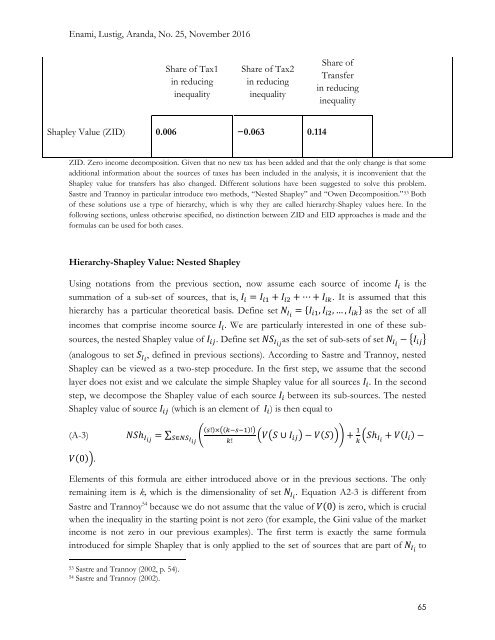IMPACT OF TAXES AND TRANSFERS
n?u=RePEc:tul:ceqwps:25&r=lam
n?u=RePEc:tul:ceqwps:25&r=lam
Create successful ePaper yourself
Turn your PDF publications into a flip-book with our unique Google optimized e-Paper software.
Enami, Lustig, Aranda, No. 25, November 2016<br />
Share of Tax1<br />
in reducing<br />
inequality<br />
Share of Tax2<br />
in reducing<br />
inequality<br />
Share of<br />
Transfer<br />
in reducing<br />
inequality<br />
Shapley Value (ZID) 0.006 −0.063 0.114<br />
ZID. Zero income decomposition. Given that no new tax has been added and that the only change is that some<br />
additional information about the sources of taxes has been included in the analysis, it is inconvenient that the<br />
Shapley value for transfers has also changed. Different solutions have been suggested to solve this problem.<br />
Sastre and Trannoy in particular introduce two methods, “Nested Shapley” and “Owen Decomposition.” 53 Both<br />
of these solutions use a type of hierarchy, which is why they are called hierarchy-Shapley values here. In the<br />
following sections, unless otherwise specified, no distinction between ZID and EID approaches is made and the<br />
formulas can be used for both cases.<br />
Hierarchy-Shapley Value: Nested Shapley<br />
Using notations from the previous section, now assume each source of income Ḭ i is the<br />
summation of a sub-set of sources, that is, Ḭ i = Ḭ i1 + Ḭ i2 + ⋯ + Ḭ ik . It is assumed that this<br />
hierarchy has a particular theoretical basis. Define set N Ii = {Ḭ i1 , Ḭ i2 , … , Ḭ ik } as the set of all<br />
incomes that comprise income source Ḭ i . We are particularly interested in one of these subsources,<br />
the nested Shapley value of Ḭ ij . Define set NS Iij as the set of sub-sets of set N Ii − {Ḭ ij }<br />
(analogous to set S Ii , defined in previous sections). According to Sastre and Trannoy, nested<br />
Shapley can be viewed as a two-step procedure. In the first step, we assume that the second<br />
layer does not exist and we calculate the simple Shapley value for all sources Ḭ i . In the second<br />
step, we decompose the Shapley value of each source Ḭ i between its sub-sources. The nested<br />
Shapley value of source Ḭ ij (which is an element of Ḭ i ) is then equal to<br />
(A-3) NSh Iij = ∑ ( (s!)×((k−s−1)!)<br />
(V(S ∪ Ḭ ij ) − V(S))) + 1 (Sh k<br />
I i<br />
+ V(Ḭ i ) −<br />
V(0)).<br />
S∈NS Iij<br />
k!<br />
Elements of this formula are either introduced above or in the previous sections. The only<br />
remaining item is k, which is the dimensionality of set N Ii . Equation A2-3 is different from<br />
Sastre and Trannoy 54 because we do not assume that the value of V(0) is zero, which is crucial<br />
when the inequality in the starting point is not zero (for example, the Gini value of the market<br />
income is not zero in our previous examples). The first term is exactly the same formula<br />
introduced for simple Shapley that is only applied to the set of sources that are part of N Ii to<br />
53 Sastre and Trannoy (2002, p. 54).<br />
54 Sastre and Trannoy (2002).<br />
65



